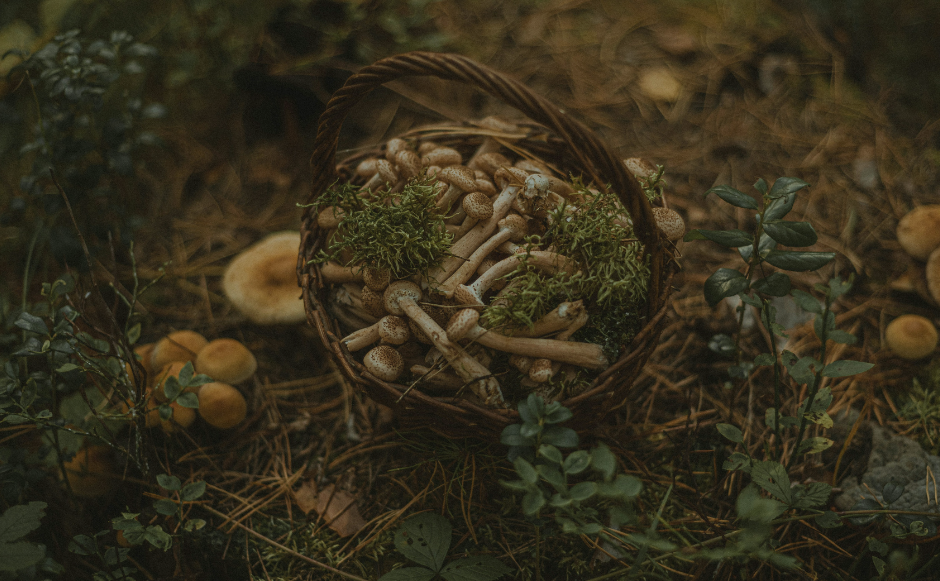Foraging for food in the wild offers a unique opportunity to connect with nature, enhance self-sufficiency, and embrace a simpler lifestyle. This age-old practice involves gathering edible plants, fungi, nuts, and other natural resources directly from their environments. For those living off-grid, foraging can be a valuable way to supplement food stores with fresh, nutritious ingredients found in woods, fields, and hedgerows.
Beyond the practical benefits, foraging provides a chance to develop new skills and deepen your understanding of the natural world. It’s not just about gathering food – it’s about recognising seasonal rhythms, learning to identify plants and fungi, and gaining respect for the ecosystems surrounding us.
However, foraging for food in the wild requires knowledge, care, and responsibility. Explore the essential aspects of safe and sustainable foraging, from understanding the foods you can gather to respecting the environment. Discover a wealth of wild edibles, learn how to identify them, and find inspiration in recipes suited for off-grid kitchens. Whether you’re new to foraging or looking to expand your skills, this article will provide the tools and knowledge to forage safely, sustainably, and with confidence.
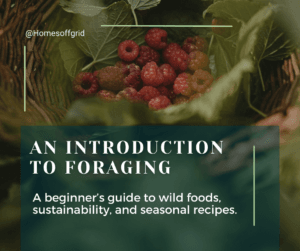
Safety and Education
Foraging is a rewarding activity, but safety and education are essential to ensure your experience is both enjoyable and risk-free. A responsible approach to foraging protects you and the environment while helping you build confidence in identifying and gathering wild foods.
Know Your Food: When foraging, the golden rule is simple: only eat what you’re 100% certain is safe. If in doubt, leave it out. Many edible plants and fungi have toxic lookalikes, so it’s crucial to identify each item with absolute confidence. Even when you’re sure, taste-test small samples first to rule out any individual reactions. Using reliable resources, such as foraging books, experienced mentors, or identification apps, can help you distinguish between safe and unsafe options. These tools provide a foundation of knowledge, which is especially important for beginners.
Safe Foraging Practices: Where and how you forage can significantly impact the safety of what you collect. Avoid areas prone to contamination, such as busy roadsides, industrial sites, or places heavily frequented by dogs, where soil and plants may carry harmful pollutants or bacteria. Always wash your finds thoroughly before consuming them to remove dirt and potential contaminants.
Legal Considerations: Foraging isn’t just about knowing which wild plants can be food – it’s also about respecting the law. In many places, you can collect wild foods for personal use on public land, but local restrictions may apply. Foraging on private land typically requires the owner’s permission, so it’s essential to understand and follow the regulations in your area. By adhering to these legal guidelines, you can enjoy your foraging activities responsibly.
With the right knowledge and precautions, foraging can be an excellent way to source food from the wild. Whether you’re collecting leaves, berries, or fungi, prioritising safety ensures your foraging adventures remain a positive experience.
Sustainability and Environmental Responsibility
Foraging is not only about finding fresh, natural food but also about respecting and preserving the wild environment that provides them. Sustainable and ethical practices ensure that the ecosystems you rely on remain healthy and abundant for future generations.
Take Only What You Need: When harvesting wild food, it’s crucial to take only what you require. Leaving enough behind ensures plants and fungi can regrow and continue to support local wildlife. Many animals, such as birds and small mammals, depend on the same resources you’re foraging. Avoid overharvesting an area of its edible offerings, as this can harm the balance of the ecosystem and reduce availability in the future.
Leave No Trace: Foraging should have as little environmental impact as possible. Respect the land by leaving it as you found it – or in better condition. Avoid trampling sensitive habitats or damaging plants unnecessarily. When collecting, use tools carefully to minimise disturbance, and never uproot plants unless it’s absolutely necessary. By practicing restraint and mindfulness, you can protect delicate ecosystems while enjoying their bounty.
Understand Your Impact: Foraging can either support or harm local ecosystems, depending on your approach. Harvesting invasive species, for example, can help control their spread and benefit native flora. Conversely, overharvesting or disturbing sensitive areas can weaken biodiversity and damage habitats. Be mindful of ethical considerations when foraging near protected wildlife areas or in locations where certain species may already be under threat. Research local guidelines to understand which practices align with the health of your environment.
By adopting sustainable foraging habits, you can enjoy the fruits of nature while ensuring its long-term vitality. This balance is at the heart of a responsible and rewarding foraging experience.
Foods You Can Forage
Foraging for food in the wild provides access to a diverse range of edible plants, fungi, and other natural resources. Below is a breakdown of some common food types, along with guidance on where to find them, identifying features, and tips for safe and sustainable harvesting.
Fungi
Many mushrooms have dangerous lookalikes, making them one of the riskiest food types to forage. Always use a reliable guidebook or seek expert advice when foraging mushrooms. Never eat a mushroom unless you are entirely confident in its identification.
- Chanterelles: Chanterelles are prized for their delicate, peppery flavour and are commonly found in damp, shaded woodlands, particularly under beech, birch, and oak trees. Look for their distinctive golden-yellow funnel shape with wavy edges. They emit a fruity, apricot-like aroma. Chanterelles are excellent in sautés, soups, or as a topping for toast. Beware of the false chanterelle, which is similar in appearance but has thinner, brittle flesh and lacks the fruity aroma.
- Porcini (Cep or Penny Bun): Porcini thrive in mixed woodlands under oak, chestnut, and spruce trees. Look for their thick brown caps and spongy undersides instead of gills. Porcini are perfect for drying, adding rich flavour to risottos, stews, and pasta dishes. Avoid the bitter bolete, which has a similar shape but tastes unpleasant and can cause stomach upset.
- Oyster Mushrooms: Oyster mushrooms grow in clusters on decaying hardwood trees like beech, oak, and aspen. Their shell-like shape and smooth, light grey to tan colouring make them relatively easy to identify. They are versatile, mild mushrooms that work well in stir-fries, soups, and as a meat substitute. Be cautious of similar-looking fungi, such as angel wings, which are toxic in large quantities.
- Morels: Morels are found in damp, sandy soil near ash, elm, or sycamore trees. Their honeycomb-like caps make them easy to spot. Morels are great in sauces and risottos with the darker specimens being earthier and nuttier in flavour. Avoid the false morel, which can cause severe poisoning.
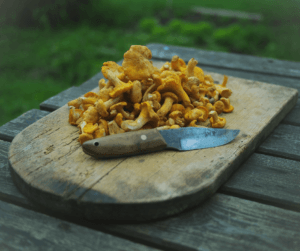
Nuts
- Hazelnuts: Hazelnuts grow on hazel trees, which are found in hedgerows, woodland edges, and parks. Hazel trees are small, often multi-stemmed, with round, serrated leaves. Look for clusters of green husks holding the nuts, which ripen to brown in early autumn. They can be eaten raw, roasted, or blended into spreads and nut butter. Hazelnuts are also a staple in baking.
- Sweet chestnuts: Sweet chestnuts grow on tall trees with long, pointed leaves that have serrated edges. These trees are commonly found in woodland areas and parks. The nuts are encased in spiky green husks that split open when the nuts ripen in autumn. Roast chestnuts for a sweet, nutty snack, or grind them into flour for gluten-free baking. Do not confuse them with horse chestnuts, which have smoother husks and are toxic to humans.
- Acorns: Acorns are the seeds of oak trees, which are easily identifiable by their lobed leaves. Look for these trees in forests, parks, and open countryside. Acorns fall to the ground in autumn and can be gathered before wildlife consumes them. After leaching tannins by soaking or boiling, acorns can be ground into flour or used in soups and stews. Never eat raw acorns, as the bitter tannins can cause digestive upset. Ensure you properly process them before consumption.
- Beechnuts: The triangular beechnuts come from beech trees and can be eaten raw in small quantities or roasted. Beech trees have smooth, grey bark and oval leaves with wavy edges.
- Walnuts: Walnuts are found in clusters on walnut trees, with large, compound leaves. Walnuts are encased in green husks that darken and split open in autumn.
Berries
- Blackberries: Blackberries are among the easiest and most popular berries to forage. These dark, juicy fruits grow on brambles, are commonly found in hedgerows, woodland edges, and even urban areas. Blackberries ripen turning red then black when ready to harvest. They can be eaten fresh, baked into pies, or made into jams and syrups. Blackberries also freeze well for long-term storage. Be careful when picking, as brambles are armed with sharp thorns.
- Elderberries: Elderberries grow on elder trees, which are small to medium-sized with compound leaves and clusters of dark purple-black berries in late summer. Look for them along riverbanks, hedgerows, and woodland edges. Known for their immune-boosting properties, elderberries are perfect for making syrups, wines, and jams. Raw elderberries, leaves, and stems contain toxins (including cyanogenic glycosides) that can cause stomach upset; cooking neutralises these compounds, making them safe to eat.
- Rose Hips: Rose hips are the bright red or orange fruit of wild roses. They are easy to spot growing on thorny bushes in hedgerows, meadows, and parks. The fruit is oval-shaped with a smooth or slightly wrinkled surface. High in vitamin C, rose hips are used to make teas, syrups, jellies, and even skincare products. Inside the fruit are hairy seeds that can irritate the digestive tract, always strain anything you make to remove these hairs.
- Sloes: Sloes are small, blue-black berries that grow on blackthorn bushes. These shrubs are often found in hedgerows and woodland edges, easily identified by their spiny branches and small oval leaves. The berries are best harvested after the first frost, which softens their tartness. Traditionally used to flavour gin, sloes can also be made into jams, jellies, or cordials. They are very bitter when eaten raw and should be processed to improve their flavour.

Wild Greens
- Nettles: Nettles are one of the most versatile wild greens and are found almost everywhere, from woodland edges to roadside verges. Young leaves are best, as older leaves can become tough and gritty. Nettles can be used in teas, soups, or as a spinach substitute. Wear gloves when harvesting to avoid the stinging hairs and cook to neutralise them. This makes them safe to eat.
- Wild Garlic: Wild garlic thrives in shaded, damp woodlands and is easily recognised by its strong garlic aroma and broad, shiny leaves. It often grows in large patches, making it easy to collect. Small white flowers appear in spring, which are also edible. Use the leaves for pesto, soups, or in salads. Be careful not to confuse wild garlic with poisonous plants like lily of the valley or autumn crocus, which have similar leaves but lack the garlic smell.
- Dandelion: Dandelion leaves are slightly bitter greens found in fields, gardens, and even cracks in pavements. They are most tender before the plant flowers. The bright yellow flowers and roots of the dandelion are also edible and useful. Leaves can be eaten in salads or cooked to reduce their bitterness and are rich in vitamins and minerals. The flowers can be used to make wine while the roots can be roasted and ground to make a caffeine-free coffee substitute.
- Chickweed: Chickweed grows abundantly in gardens, meadows, and shaded areas. It is a low-growing plant with small, oval leaves and tiny white flowers. The tender stems and leaves are best for harvesting. Chickweed has a mild flavour and can be eaten raw in salads, blended into pesto, or added to soups. It is also used as a herbal remedy for soothing skin conditions. Avoid mistaking chickweed for less palatable or toxic lookalikes, such as scarlet pimpernel.
Roots and Tubers
- Wild carrots: Also known as Queen Anne’s Lace, are found in open fields, meadows, and along roadsides. They have feathery, fern-like leaves and a white, umbrella-shaped cluster of flowers. The root is small, white, and has a distinctive carrot-like aroma when crushed. The roots can be eaten raw or cooked but are best harvested when young, as older roots become tough and fibrous. Wild carrots can be used in soups, stews, or roasted as a side dish. The seeds can also be used as a spice, offering a warm, earthy flavour. Wild carrots closely resemble the highly toxic hemlock and water hemlock. Always verify identification by checking for the carrot-like smell and hairy stems (hemlock stems are smooth and often have purple blotches). If in doubt, do not harvest.
- Burdock: This is a biennial plant found in hedgerows, meadows, and disturbed soils. It has large, heart-shaped leaves and produces purple, thistle-like flowers. Its long taproots, which can grow over a foot in length, are best harvested in the plant’s first year before it flowers. The roots are rich in inulin, a prebiotic fibre, and can be peeled, sliced, and added to soups, stews, or stir-fries. Burdock tea is also popular, valued for its detoxifying properties. Ensure correct identification, as burdock may be mistaken for other plants in the thistle family.
- Cattail Roots: Found in marshes, the roots of cattails are starchy and can be boiled or roasted. Their shoots and pollen are also edible. Be careful not to confuse these with iris as they are toxic.
Other Forgeable Plants
- Pine Needles: Pine needles are a readily available resource found on pine trees in forests, woodlands, and even parks. Look for species like white pine or red pine, which are safe for consumption. The needles are typically long, thin, and bundled in groups of two to five, depending on the species. Pine needles can be steeped in hot water to create a vitamin C-rich tea with a mild, citrusy flavour. The tea is known for its immune-boosting and anti-inflammatory properties. Pine needles can also be used as a seasoning or smoked to impart a unique flavour to meats. Avoid foraging needles from toxic species such as yew or Norfolk Island pine. Yew needles are flat and dark green, while Norfolk Island pine has softer, brush-like needles. Always confirm the tree species before consuming.
- Elderflower: Found on elder trees, these white, fragrant blossoms can be harvested for syrups, cordials, or to flavour baked goods.
- Wild Violets: These delicate purple or white flowers grow in woodlands and gardens. Their sweet flavour makes them ideal for garnishing cakes, salads, or infused syrups.
- Maple Seeds: These winged seeds, or “helicopters,” can be roasted and eaten as a snack. Look for them on sugar maples or similar species.
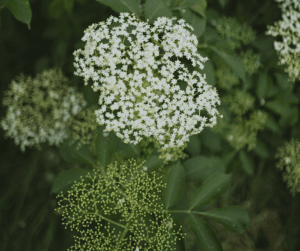
Foraging Calendar
Seasonality and geography play a vital role in determining what you can forage throughout the year. Many plants and fungi are only available at specific times, depending on their growth cycles and local climate. Their availability can differ due to weather, altitude, and other factors.
January: Though winter limits options, this is a great time to forage for hardy plants.
- Sweet chestnuts
- Oyster mushrooms
- Pine needles
- Chickweed
February: Late winter offers early greens and continued supplies of nuts and fungi.
- Wild garlic (early shoots)
- Nettles
- Velvet shank mushrooms
- Sweet chestnuts
- Dandelion roots
March: Spring plants begin to emerge with tender greens and edible flowers.
- Wild garlic (full leaves)
- Young nettle shoots
- Dandelion leaves
- Sorrel
- Primrose flowers
April: Spring is a great time for greens, roots, and early fruits.
- Wild garlic (flowers begin)
- Alexanders
- Dandelion blossoms
- Wood sorrel
- Wild violets
May: Late spring brings a range of edible plants and early berries.
- Elderflowers
- Hawthorn blossoms
- Wild strawberries
- Chives
- Goosegrass (cleavers)
June: Early summer provides berries and the first nuts while greens are still present.
- Blackberries (early varieties)
- Elderflowers (late blossoms)
- Wild cherries
- Burdock roots
- Nettle seeds
July: Mid-summer brings fruits, flowers and mushrooms.
- Raspberries
- Wild blueberries (bilberries)
- Chanterelles
- Meadowsweet flowers
- Rose petals
August: Late summer is peak berry season.
- Blackberries
- Elderberries
- Puffball mushrooms
- Rowan berries
- Hazel nuts
September: Hedgerows and woodlands are at their most abundant.
- Sloes
- Hawthorn berries
- Crab apples
- Sweet chestnuts
- Porcini mushrooms
October: Autumn offers plenty of nuts, fruits, and fungi.
- Beech nuts
- Acorns
- Chanterelles
- Rose hips
- Field mushrooms
November: As the year winds down, focus shifts to preserved or hardy items.
- Sweet chestnuts
- Oyster mushrooms
- Pine nuts
- Jerusalem artichokes
- Kale (wild varieties)
December: A lean time for foraging, but some items remain accessible for the dedicated.
- Pine needles
- Chickweed
- Velvet shank mushrooms
- Dandelion roots
Recipe Ideas for Foraged Foods
Once you’ve finished foraging in the wild for your food, the next step is to bring it to life in the kitchen. Below are some simple recipe ideas that make the most of wild edibles, perfect for an off-grid lifestyle where simplicity and sustainability are key.
Nettle Soup
Nettles are a versatile wild green, abundant in early spring. This soup is a warming, nourishing dish that’s easy to make with just a few ingredients.
- Ingredients: Fresh nettles, onion, garlic, vegetable stock, olive oil, salt, pepper.
- Method: Sauté chopped onion and garlic in olive oil. Add a few handfuls of nettles, cover with vegetable stock, and simmer until tender. Blend until smooth, then season to taste. Serve with a slice of homemade bread.
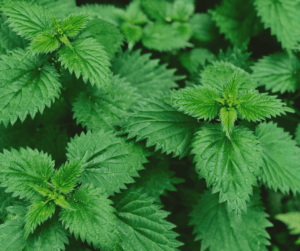
Berry Syrups or Jams
Foraging berries such as blackberries or elderberries can provide delicious syrups or jams, perfect for prolonging the taste of summer.
- Ingredients: Foraged berries, sugar, lemon juice, water.
- Method: Simmer the berries with water, then strain to remove seeds and pulp if preferred. Add sugar and lemon juice, and simmer again until thickened. Pour into sterilised jars and store for months of enjoyment.
Wild Garlic Pesto
Wild garlic, found in woodlands in spring, makes a fragrant alternative to traditional basil pesto. This recipe is quick, full of flavour, and perfect for adding a fresh twist to pasta, sandwiches, or even as a dip.
- Ingredients: Wild garlic leaves, olive oil, parmesan (optional), pine nuts or walnuts, garlic, salt, pepper.
- Method: Blend the wild garlic with oil, nuts, and garlic. Add parmesan for richness and season with salt and pepper. Store in a jar with a layer of oil on top to preserve.
Mushroom Stew
Foraged mushrooms like chanterelles or porcini make a hearty, earthy stew. This dish is perfect for autumn or winter when mushrooms are plentiful.
- Ingredients: Foraged mushrooms, onion, garlic, vegetable or chicken stock, butter, fresh thyme, salt, pepper.
- Method: Sauté onions and garlic in butter, then add the chopped mushrooms. Cook until tender, then add stock and thyme. Simmer for 15-20 minutes. Season with salt and pepper, and serve with crusty bread.
Acorn Flour Pancakes
If you’ve foraged acorns, you can grind them into flour and use it to make sustainable, gluten-free pancakes. This recipe is a great way to make the most of acorns after they’ve been processed.
- Ingredients: Acorn flour, regular flour (optional), baking powder, eggs, milk, sugar, butter.
- Method: Mix the acorn flour with baking powder, sugar, and flour if using. Beat in eggs and milk, to create a batter then cook in a buttered pan until golden. Serve with maple syrup or fresh berries.
By incorporating these recipes into your off-grid lifestyle, you’ll not only enjoy the results of your foraging efforts but also expand your knowledge of wild food. Whether you’re using wild greens for a fresh soup or preserving berries for the winter, foraging allows you to connect with nature in a new way, all while making the most of what the land provides.
To find out more about off-grid cooking click here.
Tools and Resources for Foraging
To make the most of your foraging experience, it’s important to be well-equipped with the right tools and resources. These will not only help you forage more efficiently but also ensure you do so safely and sustainably.
Foraging Field Guides and Apps
Foraging requires good identification skills, and a reliable field guide can be a valuable resource. Here are some excellent options to guide your foraging journey:
- Field Guides: Books such as The Forager’s Handbook by Miles Irving or Wild Food by Roger Phillips offer clear descriptions and images to help identify edible plants, fungi, and berries. A good guide will also include information on toxic lookalikes and the best times to forage each item.
- Apps: Technology can provide an added layer of confidence when identifying plants and fungi. Apps like PlantSnap, or Picture This allow you to snap a photo and receive instant identification feedback. These apps are often community-driven, so you can also learn from others’ experiences. However, these apps should not be relied on entirely as they can misidentify some species.
- Websites: Websites like Wild Food UK or Countryfile offer helpful foraging guides, blogs, and even recommendations for foraging courses. These can be valuable for learning more about the seasonal availability of wild edibles in your area.
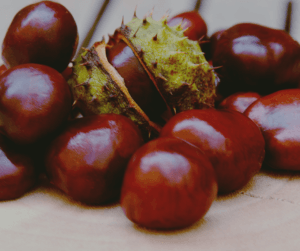
Essential Foraging Tools
While foraging doesn’t require a lot of equipment, having a few key tools can make the process easier and more efficient.
- Basket or Bag: A sturdy basket, cloth bag, or reusable shopping bag is essential for collecting your foraged items. Baskets are preferable, as they allow plants to breathe and reduce the risk of damaging delicate leaves or mushrooms.
- Gloves: Gloves help protect your hands from thorns, stingers, or rough plants. They’re especially useful when handling nettles, brambles, or plants with sharp leaves.
- Small Knife or Shears: A small, sharp knife or pruning shears can make harvesting easier, particularly for plants with tough stems, mushrooms, or woody herbs. They also allow you to cut cleanly without damaging the plant or root system.
- Brush: A small brush is handy for cleaning mushrooms or root vegetables. It helps remove dirt and debris without damaging the food. A soft-bristled brush is best for delicate items like fungi.
Joining Local Foraging Groups
Foraging can be a solitary or social activity, depending on your preferences. If you’re new to foraging, joining a local foraging group can provide invaluable support, knowledge, and community. These groups often offer foraging walks, workshops, and discussions where you can learn more about finding food in the wild from experienced foragers.
- Mentorship: Many local groups offer mentorship programs where more seasoned foragers guide beginners. This hands-on learning experience allows you to practice identifying plants in the wild and gain confidence in your foraging skills.
- Community Learning: Foraging groups can also connect you with like-minded individuals who share your interest in wild food. These communities often share tips, recipes, and local foraging hotspots, making your foraging experience richer and more enjoyable.
By utilising the right tools and resources, you can ensure your foraging is safe, sustainable, and enjoyable. Whether you’re learning from a book, using an app to identify a new find, or connecting with a community of fellow foragers, these resources will help you become a confident and responsible forager.
Conclusion
Foraging is a rewarding practice that brings you closer to nature, enhances your self-sufficiency, and provides a deeper appreciation for the world around you. It offers a unique opportunity to gather fresh, free ingredients while learning about the seasonal cycles and diverse ecosystems that sustain them. Whether you’re collecting wild greens, mushrooms, or berries, foraging not only supplements your off-grid lifestyle but also connects you to the environment in a way that modern life often doesn’t allow.
As you begin your foraging journey, remember to start small and prioritise safety. Take time to learn the plants and fungi in your area, use reliable resources, and always follow sustainable practices. Foraging for food in the wild is a skill that develops over time, so embrace the learning process and gradually expand your knowledge and confidence.
By respecting the environment, foraging responsibly, and continuously educating yourself, you’ll be able to enjoy all the benefits that this ancient practice has to offer, while contributing to a more sustainable and fulfilling lifestyle.
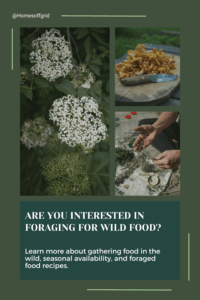
To find out more about other aspects of off-grid living return to our Reading Room.
Disclosure: This post contains affiliate links. This means we receive a commission if you decide to purchase through our links, at no extra cost to you. We will only recommend products that we use and trust. The majority of links are for Amazon, most books are available elsewhere but Amazon provides reviews and helpful descriptions.


